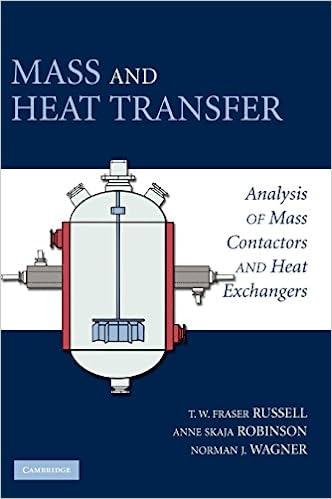Question
PLease read the whole question: Because part of this is already answered on the site and some answers are correct sand others are wrong, don't
PLease read the whole question: Because part of this is already answered on the site and some answers are correct sand others are wrong, don't repost what is already there.
what we are given, so you have all information:
A cooling coil made of copper tube is immersed in a regulated constant temperature bath held at a temperature of 20 C. The liquid flowing through the tube enters at T = 22 C, and the coil must be sufficiently long to ensure the exit liquid sustains a temperature of T = 20.5 C. The bath is so well stirred that heat transfer resistance at the tube-bath interface is minimal, and the copper wall resistance can also be ignored. Thus, the tube wall temperature (TW) can be taken equal to the bath temperature. Use the following equation to estimate the required tube length (Z) To - T = exp(-2(Pi)Rhz) where As is the surface area of the tube while A is the cross sectional area. Assume the following conditions for the flowing liquid: Heat capacity Tube radius Average velocity Density Viscosity Thermal conductivity Co = 1 kcal/kg. C R = 0.01 m v. = 1 m/s p=103 kg/m3 M = 0.001 kg/m.s k = 1.43 x 10-4 kcal/(s. m. K) Since the Reynolds number is in the turbulent range, use the following correlation of Sieder and Tate (Bird et al. 1960) to calculate the heat transfer coefficient, h Nu = 0.026 Re08 Pr1/3 where (D = 2R) Nu = Pr = sple Re = DVOP (Nusselt number) (Prandtl number) (Reynolds number) AND THIS IS SOLVED TO EQUAL EQUATION OF LENGTH AT 7meters
but I am having trouble on where to start on how do we take that equation we have and apply it in the next part of ... which is use forward and backward difference approximations of O(h) and a centered difference approximation of O(h2) to estimate dT/dz of the above equation at that calculated tube length (L) using a step size h = 0.5 m. Determine true percent relative error for all methods.
Step by Step Solution
There are 3 Steps involved in it
Step: 1

Get Instant Access to Expert-Tailored Solutions
See step-by-step solutions with expert insights and AI powered tools for academic success
Step: 2

Step: 3

Ace Your Homework with AI
Get the answers you need in no time with our AI-driven, step-by-step assistance
Get Started


